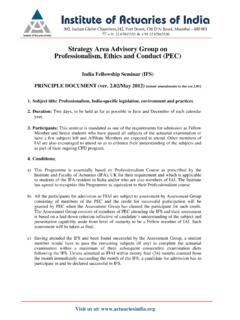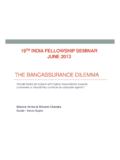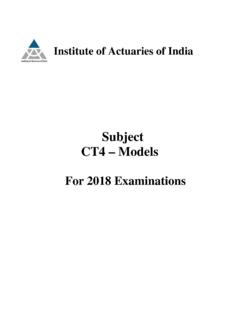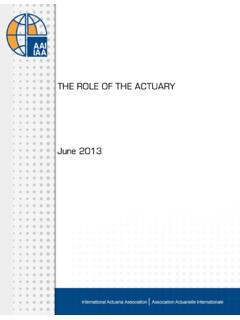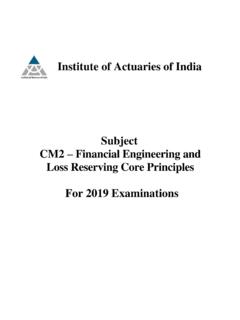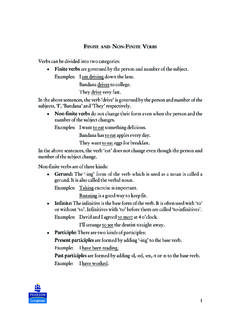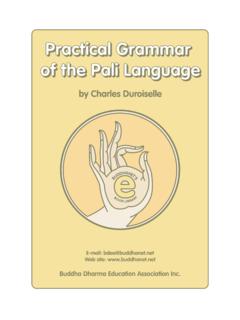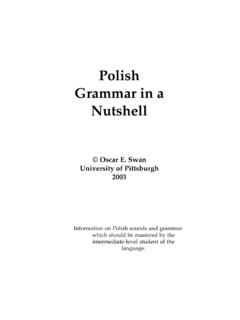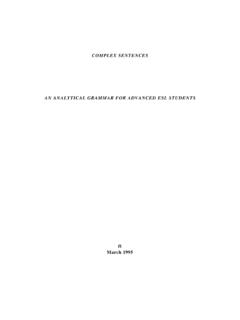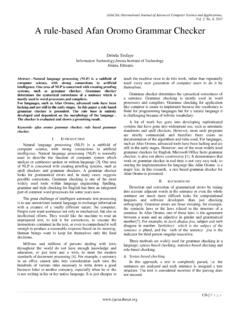Transcription of Subject CS2 Risk Modelling and Survival Analysis Core ...
1 ` Institute of Actuaries of India Subject CS2 Risk Modelling and Survival Analysis Core Principles For 2019 ExaminationsCS2 Risk Modelling and Survival Analysis Core Principles Page 1 of 10 Aim The aim of the Actuarial Statistics 2 Subject is to provide a grounding in mathematical and statistical Modelling techniques that are of particular relevance to actuarial work, including stochastic processes and Survival models and their application. Competences On successful completion of this Subject , a student will be able to: 1234describe and use statistical distributions for risk Modelling . describe and apply the main concepts underlying the Analysis of time series models. describe and apply Markov chains and processes. describe and apply techniques of Survival Analysis . describe and apply basic principles of machine learning. Links to other subjects This Subject assumes that the student is competent with the material covered in CS1 Actuarial Statistics 1 and the required knowledge for that Subject .
2 CM1 Actuarial Mathematics 1 and CM2 Actuarial Mathematics 2 apply the material in this Subject to actuarial and financial Modelling . Topics in this Subject are further built upon in SP1 Health and Care Principles, SP7 General Insurance Reserving and Capital Modelling Principles, SP8 General Insurance Pricing Principles and SP9 Enterprise Risk Management Principles. 5Pa ge 2 of 10 CS2 - Risk Modelling and Survival Analysis Core Principles Syllabus topics 1 2 3 4 5 Random variables and distributions for risk Modelling (20%) Time series (20%) Stochastic processes (25%) Survival models (25%) Machine learning (10%) The weightings are indicative of the approximate balance of the assessment of this Subject between the main syllabus topics, averaged over a number of examination sessions. The weightings also have a correspondence with the amount of learning material underlying each syllabus topic.
3 However, this will also reflect aspects such as: the r elative complexity of each topic, and hence the amount of explanation and support required for it. the n eed to provide thorough foundation understanding on which to build the other objectives. the e xtent of prior knowledge which is expected. the d egree to which each topic area is more knowledge or application levels The use of a specific command verb within a syllabus objective does not indicate that this is the only form of question which can be a sked on t he topic covered by that objective. The Examiners may ask a question on any syllabus topic using any of the agreed command verbs, as are defined in the document Command verbs used in the Associate and F ellowship written examinations . Questions may be set a t any skill level: Knowledge (demonstration of a detailed knowledge and u nderstanding of the t opic), Application (demonstration of an ability to apply the principles underlying the topic within a given context) and Higher Order (demonstration of an ability to perform deeper Analysis and assessment of situations, including forming judgements, taking into account different points of view, comparing and contrasting situations, suggesting possible solutions and actions, and making recommendations).
4 In the CS subjects, the approximate split of assessment across the three skill types is 20% Knowledge, 65% Application and 15% Higher Order skills. Page 3 of 10 CS2 - Risk Modelling and Survival Analysis Core Principles Detailed syllabus objectives 1 Random variables and distributions for risk Modelling (20%) Loss distributions, with and without risk sharing Describe the properties of the s tatistical distributions which are suitable for Modelling individual and aggregate losses. Explain the c oncepts of excesses (deductibles), and retention limits. Describe the operation of simple forms of proportional and e xcess of loss reinsurance. Derive the d istribution and corresponding moments of the claim amounts paid by the insurer and the reinsurer in the presence of excesses (deductibles) and r einsurance. Estimate the p arameters of a failure time or loss distribution when the data i s complete, or when it is incomplete, using maximum likelihood and the m ethod of moments.
5 Fit a statistical distribution to a dataset and calculate appropriate goodness of fit measures. Compound distributions and their applications in risk Modelling Construct models appropriate for short term insurance contracts in terms of the numbers of claims and the a mounts of individual claims. Describe the major simplifying assumptions underlying the models in Define a compound Poisson distribution and show that the sum of independent random variables each having a compound Poisson distribution also has a compound Poisson distribution. Derive the mean, variance and coefficient of sk ewness for compound binomial, compound Poisson and compound negative binomial random variables. Repeat for both the insurer and the reinsurer after the operation of simple forms of p roportional and excess of loss reinsurance. Page 4 of 10 CS2 - Risk Modelling and Survival Analysis Core Principles Introduction to copulas Describe how a copula can be c haracterised as a multivariate distribution function which is a function of the marginal distribution functions of its variates, and explain how this allows the marginal distributions to be investigated separately from the dependency between them.
6 Explain the meaning of the terms dependence or concordance, upper and l ower tail dependence; and s tate in general terms how tail dependence can b e used to help select a copula suitable for Modelling particular types of risk. Describe the form and characteristics of the Gaussian copula and the A rchimedean family of copulas. Introduction to extreme value theory Recognise extreme value distributions, suitable for Modelling the distribution of severity of loss and their relationships Calculate various measures of tail weight and i nterpret the results to compare the t ail weights. 2 Time series (20%) Concepts underlying time series models Explain the c oncept and general properties of stationary, I(0), and i ntegrated, I( 1), univariate time series. Explain the concept of a stationary random series. Explain the concept of a filter applied to a stationary random series.
7 Know the n otation for backwards shift operator, backwards difference operator, and the c oncept of r oots o f the characteristic equation of time series. Explain the concepts and basic properties of autoregressive (AR), moving average (MA), autoregressive moving average (ARMA) and autoregressive integrated moving average (ARIMA) time series. Explain the c oncept and properties of discrete random walks and random walks with normally distributed increments, both with and without drift. Explain the b asic concept of a multivariate autoregressive model. Explain the concept of cointegrated time series. Page 5 of 10 CS2 - Risk Modelling and Survival Analysis Core Principles Show that certain univariate time series models have the Markov property and describe how to rearrange a univariate time series model as a multivariate Markov model. Applications of time series models Outline the processes of identification, estimation and diagnosis of a time series, the criteria for choosing between models and the diagnostic tests that might be applied to the residuals of a time series after estimation.
8 Describe briefly other non-stationary, non-l inear time series models. Describe simple applications of a time series model, including random walk, autoregressive and cointegrated models as applied to security prices and other economic variables. Develop deterministic forecasts from time series data, using simple extrapolation and moving average models, applying smoothing techniques and seasonal adjustment when appropriate. 3 Stochastic processes (25%) Describe and classify stochastic processes. Define in general terms a stochastic process and in particular a counting process. Classify a stochastic process according to whether it: operates in continuous or discrete time has a continuous or a discrete state space is a mixed and give examples of each type of process. Describe possible applications of mixed processes. Explain what is meant by the Markov property in the context of a stochastic process and in terms of filtrations.
9 Define and apply a Markov chain. State the e ssential features of a Markov chain model. State the C hapman-Kolmogorov equations that represent a Markov chain. Calculate the stationary distribution for a Markov chain in simple cases. Page 6 of 10 CS2 - Risk Modelling and Survival Analysis Core Principles Describe a system of frequency based experience rating in terms of a Markov chain and describe other simple applications. Describe a time-inhomogeneous Markov chain model and describe simple applications. Demonstrate how Markov chains can b e used as a tool for Modelling and h ow they can be simulated. Define and apply a Markov process. State the e ssential features of a Markov process model. Define a Poisson process, derive the distribution of the number of events in a given time interval, derive the d istribution of inter -event times, and apply these results.
10 Derive the Kolmogorov equations for a Markov process with time independent and time/age dependent transition intensities. Solve the K olmogorov equations in simple cases. Describe simple Survival models, sickness models and marriage models in terms of Markov processes and describe other simple applications. State the K olmogorov equations for a model where the transition intensities depend not only on age/time, but also on the duration of stay in one or more states. Describe sickness and marriage models in terms of duration dependent Markov processes and describe other simple applications. Demonstrate how Markov jump processes can b e used as a tool for Modelling and how they can be simulated. 4 Survival models (25%) Explain concept of Survival models. Describe the model of lifetime or failure time from age x as a random variable. State the consistency condition between the random variable representing lifetimes from different ages.

